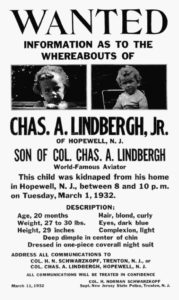The Charles A. Lindbergh Jr Kidnapping
 It was on the evening of March 1, 1932, that one of the nation’s biggest mysteries and scandals occurred. World-famous aviator Colonel Charles Lindbergh and his wife had put their 20-month old son Charles Augustus Lindbergh, Jr. to bed in his upstairs nursery and within hours a nurse who went to check-in on the baby discovered him to be missing.
It was on the evening of March 1, 1932, that one of the nation’s biggest mysteries and scandals occurred. World-famous aviator Colonel Charles Lindbergh and his wife had put their 20-month old son Charles Augustus Lindbergh, Jr. to bed in his upstairs nursery and within hours a nurse who went to check-in on the baby discovered him to be missing.
All evidence supported that the baby had been kidnapped and as police investigated Lindbergh’s home, the discovered muddy footprints in the nursery, the window in the nursery wide-open, and a cryptic ransom note left on the windowsill that demanded $50,000 for the safe return of the baby. The police thoroughly searched the grounds of the Lindbergh estate and came up empty-handed. All that they were able to discover was a home-made ladder that they believe someone used to climb to the second-story window to nab baby Charlie, as there were also scrape marks discovered on the outside of the home next to the nursery window.
It was the first time the Lindberghs were at their new home on a Tuesday night in the middle of the week. The house was not quite finished, so the family only came on weekends. They spent weekdays at Anne’s family’s estate in Englewood, New Jersey. But Charlie had a cold, and Anne didn’t want him to travel. So how did the kidnappers know they’d even be here that night?
The ransom note was very crudely written with many misspellings which led the police to believe that the individual that kidnapped baby Charles most likely had to be a recent immigrant. The note also urged the Lindbergh’s not to involve the police as there would be trouble as a result.
Colonel Lindbergh asked friends to communicate with the kidnappers, and they made widespread appeals for the kidnappers to start negotiations. A second ransom note was received by Colonel Lindbergh on March 6, 1932, (postmarked Brooklyn, New York, March 4), in which the ransom demand was increased to $70,000.
About nine days after the kidnapping of baby Charles a 72-year-old retired teacher from the Bronx named Dr. John Condon called the Lindberghs and claimed that he had written a letter to the “Bronx Home News” offering to act as an intermediary between Lindbergh and the kidnapper. The story got the attention of the kidnapper who contacted Condon and in a move of desperation to get his son back alive, Lindbergh agreed to allow Condon to works as an intermediary and kept the police out of the situation.
A month later on April 2, 1932, Dr. Condon delivered the ransom money of gold certificates (serial numbers recorded by the police) to a man at St. Raymond’s Cemetery, while Lindbergh waited in a nearby car. The man referred to as Cemetery John took the money, but failed to deliver the baby safe and sound. He instead handed Dr. Condon a note that revealed the baby’s alleged location, which was on a boat called the Nelly. Unfortunately, no boat or baby was located in the area that Cemetery John described.
Finally on May 12, 1932, nearly three months after the kidnapping of baby Charles, a truck driver found the baby’s decomposed body in the woods a few miles from the Lindbergh estate. Police claim that the baby had been dead since the night of the kidnapping and had a fractured skull which may have occurred because he was dropped when the kidnapper was attempting to climb back down the ladder. However, there are some discrepancies in the police report describing the baby’s injuries and some do not match those that would occur during an accidental fall. There was a clear fracture line on the left side of the baby’s head, and on the right side of the head, there was a round defect behind the right ear.
The police claim the injury to the right side of the head occurred when an officer who was trying to exhume the baby’s remains accidentally poked a hole in his skull with a stick, and thus created the round, impact-like injury on the right side. However many medical experts claim that a stick would not create enough force to break through the baby’s skull and some people began to suspect the baby was murdered rather than dying accidentally after the fall. The evidence supports the theory that the Lindbergh baby was killed intentionally by the kidnapper and the ransom notes claiming he was alive was only part of a ruse to receive higher amounts of money from the family.
For two years the police and FBI kept close tabs on the serial numbers associated with the ransom money that was given to Cemetery John, just waiting to see if it would pop up anywhere and they could arrest a suspect. In 1934, one of the gold certificates showed up at a gas station in New York. Thanks to the suspicions of the gas station attendant, who was worried the gold certificate might be counterfeit and wrote down a license plate number, the police were able to track the gold certificate back to an illegal German immigrant named Bruno Richard Hauptmann.
The police discovered that Hauptmann had a past criminal record, which of all things included using a ladder to climb into the second-story window of a home to steal money and watches. Police searched Hauptmann’s home and found $14,000 of the Lindbergh ransom money hidden in his garage. They also discovered missing floorboards in Hauptmann attic which matched the wood used to build the home-made ladder discovered on the Lindbergh property.
Hauptmann was arrested on September 19, 1934, and tried for murder beginning on January 2, 1935. While Hauptmann maintained his innocence, the evidence in the case was stacked against him. Not only was there the wood from the ladder, but a writing sample from Hauptmann matched the ransom note. There was also a witness that claimed to have seen Hauptmann on the Lindbergh property the day before the crime occurred. Both Lindbergh and Dr. Condon also agreed that they recognized Hauptmann as Cemetery John who had taken the ransom money right after the crime.
The prosecutors on the case were never completely positive that Hauptmann acted alone. They urged him to reveal his accomplices, but he never wavered from his innocence plea. Even his wife, Anna, maintained her husband’s innocence all the way up to her death in 1994. It is the ransom money that comes into question when looking into possible accomplices in committing this crime. Police only discovered Hauptmann with about $14,000 of the ransom money, so the questions became, what happened to the rest of the $50,000 in funds?
On February 13, 1935, the jury convicted Hauptmann of first-degree murder. He was put to death by electric chair on April 3, 1936, for the murder of Charles A. Lindbergh Jr.
The case of the Lindbergh baby is truly one of the most haunting in American History. Overall the case left many unanswered questions about who committed the crime and how they were able to pull it off. Many are still wondering if Hauptmann had any assistance when committing the crime and that there still could be perpetrators at large even to this day.
What makes this case even more intriguing is that there are some individuals who believe that the Lindbergh baby is still very much alive and well. They claim that the poster that circulated far and wide seeking his return said he was 20 months old, weighed 27 to 30 pounds and was 29 inches tall. However, the autopsy report that was completed on the baby that was discovered on the Lindbergh property couldn’t identify the body’s sex due to “marked decomposition ” and the body was 33 inches long, -4 inches taller than Charles A. Lindbergh Jr. was supposed to be. Colonel Lindbergh and Betty Gow, the baby’s nurse,, quickly identified the body when it was discovered and it was quickly cremated right after. Definitely questionable behavior, but the theory does seem a bit far-fetched!









